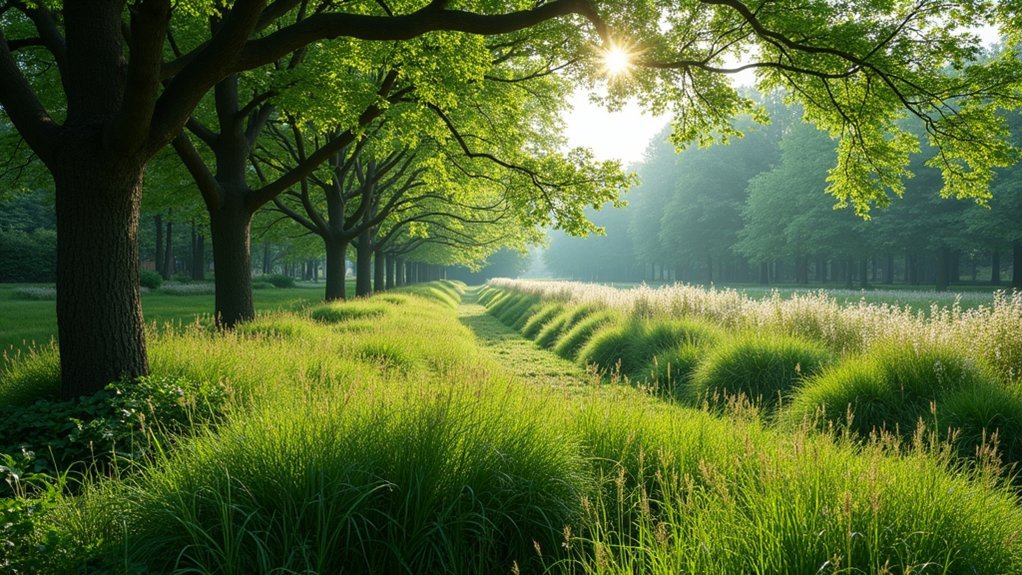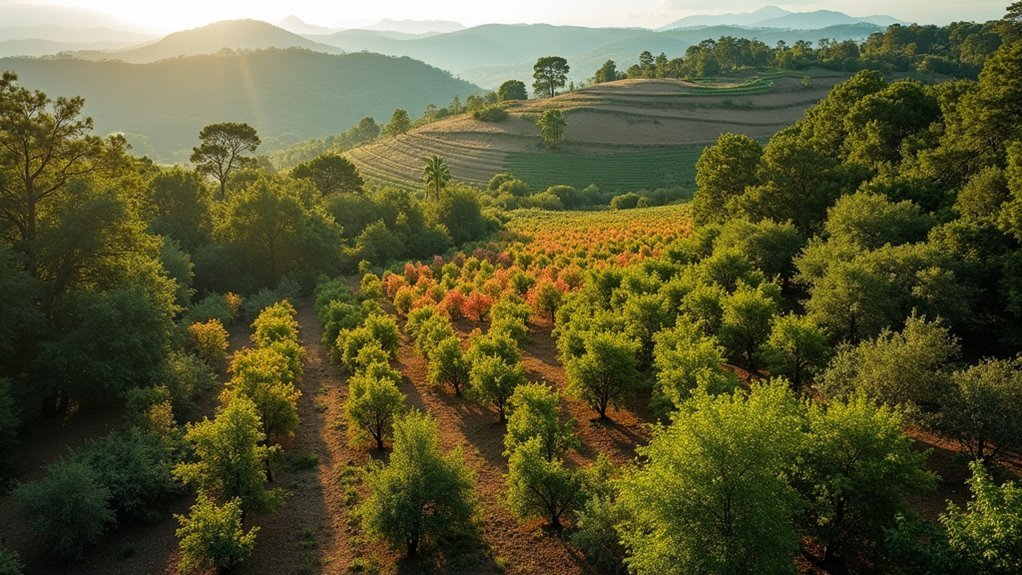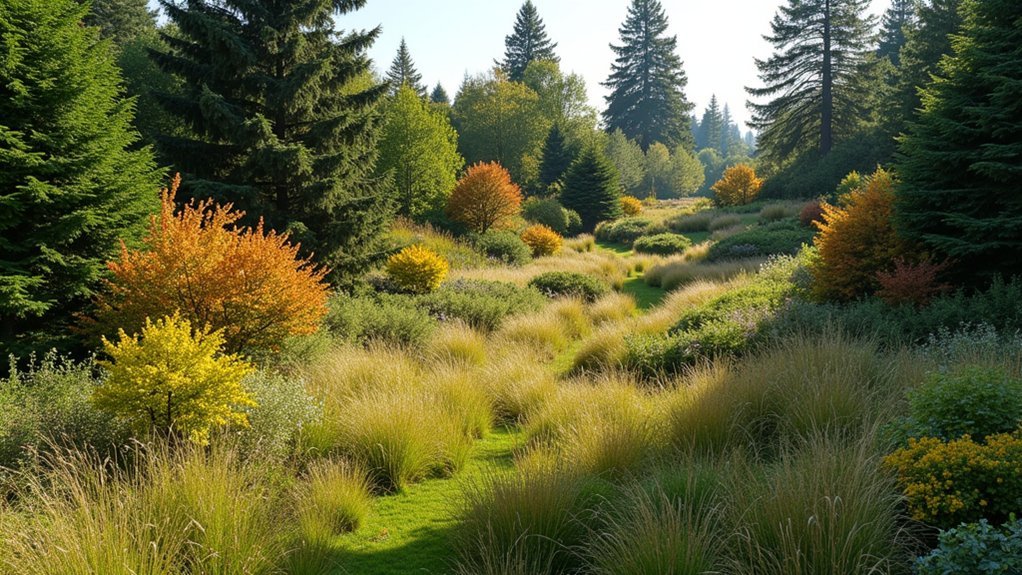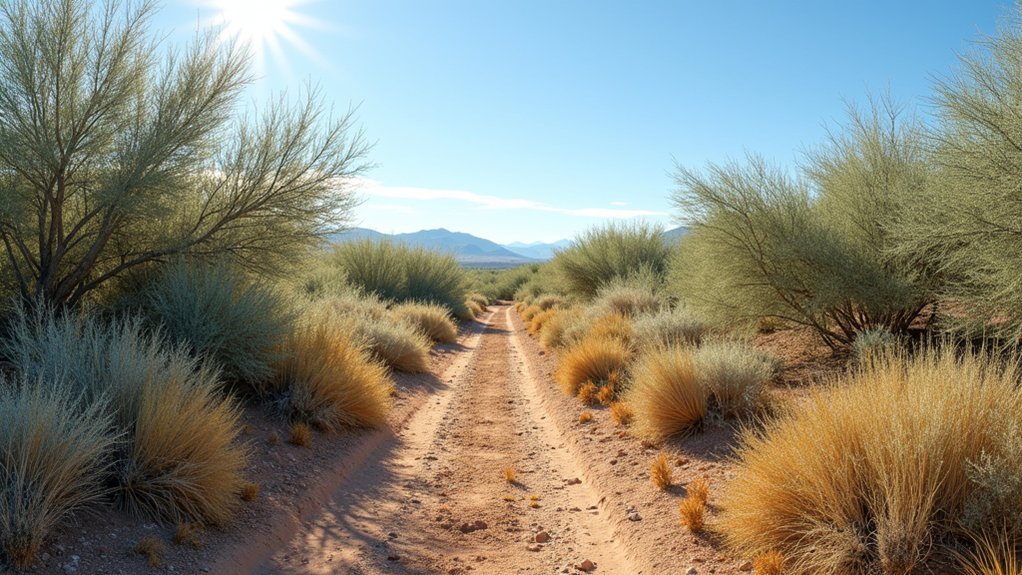Strategic windbreak plants create natural fences that protect your property from wind while enhancing privacy and supporting wildlife. For best results, design multi-layered barriers using tall trees (center), medium shrubs, and low grasses with proper spacing. Choose a mix of evergreen and deciduous species for year-round protection, and consider drought-resistant natives for challenging sites. Position your windbreak perpendicular to prevailing winds for maximum effectiveness. The following designs will transform your landscape into a functional, beautiful haven.
Multi-Layered Windbreak Design: Combining Trees, Shrubs, and Grasses

When designing an effective windbreak, you’ll achieve the best results by implementing a multi-layered approach that combines tall trees, medium-sized shrubs, and low grasses.
A multi-layered windbreak with diverse vegetation heights offers superior protection and ecological benefits.
Position your tallest trees in the center or windward row, spacing them 3-6 meters apart. Surround these with smaller shrubs and grasses in the outer rows to create a diverse natural barrier. This strategic arrangement can protect an area extending approximately 20 times the height of your tallest trees.
For maximum effectiveness, place your windbreak perpendicular to prevailing winds. This multi-layered approach not only reduces wind speed more effectively than single-species plantings but also creates valuable wildlife habitat.
Different trees and shrubs offer varied food sources and shelter, enhancing your property’s biodiversity while providing functional protection.
Evergreen Fortress: Year-Round Wind Protection Strategy
You’ll find exceptional wind protection throughout all seasons with densely-planted conifers that create an impenetrable evergreen fortress around your property.
For maximum effectiveness, arrange your evergreens in strategic layers, placing taller species like arborvitae at the back and shorter varieties like juniper or boxwood toward the front.
This multi-tiered perennial design not only blocks wind from various angles but creates a protected zone extending up to 20 times the height of your tallest trees.
Conifer Density Benefits
Unlike deciduous trees that shed their leaves in winter, conifers maintain their dense foliage throughout the year, creating a living fortress against punishing winds.
By planting these evergreens in staggered rows, you’ll maximize their windbreak potential as air filters through multiple layers at different heights.
For ideal conifer density benefits, remember:
- Aim for a 1:10 height-to-length ratio (a 2-meter tall hedge should extend 20 meters for maximum effectiveness)
- The year-round coverage provides consistent wind protection and stabilizes microclimates
- Dense plantings enhance wildlife habitat and food sources for local species
- Conifer root systems contribute to soil stability, reducing erosion on your property
You’ll enjoy not just wind protection, but also ecological benefits that transform your landscape into a thriving ecosystem.
Layered Perennial Arrangement
Three distinct layers create the perfect evergreen fortress when strategically arranged to combat winds from all directions. Position your tallest evergreen trees in the center row, spaced 3-6 meters apart, to form the backbone of your windbreak. This central row can protect an area extending up to 20 times the height of your tallest specimens.
| Position | Plant Type | Spacing |
|---|---|---|
| Center | Tall evergreens (arborvitae) | 3-6m apart |
| Middle | Medium conifers (junipers) | 2-4m apart |
| Outer | Low shrubs & perennials | 2m apart |
Your layered perennial arrangement provides year-round wind protection while supporting local wildlife. The density of your outer rows complements the height of center plantings, creating an effective barrier against harsh weather. This strategic design guarantees consistent protection through all seasons, especially winter when wind barriers are most needed.
Edible Windbreak Systems: Productive Barrier Plantings

You’ll transform your landscape protection into a food-producing asset by implementing multi-layered fruiting barriers with trees like avocado and Surinam cherry spaced 3-6 meters apart.
Your windbreak can become a nutrient-cycling guild when you combine tall fruiting trees with smaller edible shrubs and herbs that follow the 1:10 height-to-length ratio for peak functionality.
Multi-Layered Fruiting Barriers
While traditional windbreaks serve primarily as protective barriers, multi-layered fruiting barriers transform this concept into a productive agricultural strategy.
You’ll create a functional system that meets your privacy needs while yielding edible harvests.
When designing your multi-layered fruiting windbreak, position taller trees like Inga edulis and Persea americana at the center, with smaller fruiting shrubs such as Eugenia uniflora forming the outer layers.
- Space rows 2-4 meters apart, with 1-2 meters between smaller shrubs
- Aim for a height-to-length ratio of 1:10 (a 2-meter barrier needs 20 meters length)
- Create beneficial microclimates that extend your growing season
- Attract pollinators and enhance biodiversity through plant diversity
These strategic plantings reduce wind turbulence while maximizing your space for productive harvests.
Nutrient-Cycling Windbreak Guilds
Effective windbreak systems do more than just block wind—they create thriving ecosystems that cycle nutrients while producing food.
By strategically combining nitrogen-fixing trees with fruiting shrubs and beneficial herbs, you’ll establish a self-sustaining guild that enriches your soil naturally.
Plant taller species like nitrogen-fixing alders or honey locusts in the center, then surround them with productive shrubs such as elderberry or blueberry.
Complete your guild with herbs and groundcovers that attract pollinators and repel pests.
This nutrient-cycling approach supports remarkable biodiversity while providing multiple harvests.
Your edible plants benefit from improved soil fertility and protection, resulting in higher yields and healthier growth.
You’ll create a productive barrier that not only shields your property but returns ongoing harvests while building soil health year after year.
Climate-Adapted Edible Screens
Selecting the right climate-adapted plants transforms ordinary windbreaks into productive food systems that work with your local environment instead of against it.
Native fruit-bearing species like Ilex integra and Persea americana serve as excellent windbreaks while becoming a reliable food source for your family and local wildlife.
- Create a diverse mix of small trees and shrubs spaced to allow some wind to pass through while reducing damaging gusts
- Incorporate edibles like Eugenia uniflora and Phyllostachys edulis for fruits and shoots throughout seasons
- Attract pollinators and beneficial insects to improve your garden’s overall productivity
- Enjoy low maintenance barriers that improve microclimates and reduce irrigation needs
These living fences maximize land productivity while protecting your garden—essentially working double-duty as both shelter and harvest source in your landscape design.
Wildlife-Friendly Windbreak Corridors: Habitat and Protection

Beyond their practical function of reducing wind impact, windbreak corridors serve as fundamental sanctuaries for local wildlife. These wildlife-friendly structures provide shelter for birds, mammals, and insects while creating essential microhabitats with regulated temperature and humidity conditions.
Incorporating native plants into your windbreak design greatly enhances biodiversity, as these species naturally support local ecosystems and attract beneficial pollinators.
| Wildlife Benefits | Corridor Design | Seasonal Impact |
|---|---|---|
| Predation refuge | Dense understory | Winter shelter |
| Nesting habitat | Varied heights | Spring breeding |
| Food sources | Diverse species | Summer cooling |
| Travel pathways | Connected layout | Fall migration |
Your windbreak can serve as a critical wildlife corridor, allowing animals to move safely between fragmented habitats. This strategic design mitigates habitat loss while creating a thriving ecosystem right in your landscape.
Dense Growth Patterns: Spacing Techniques for Maximum Wind Reduction
When planning your windbreak, strategic spacing becomes the foundation for successful wind reduction. Effective windbreaks require at least two plant rows spaced 2-4 meters apart to create dense foliage barriers that greatly diminish wind impact.
- Position tallest trees in the center (3-6m spacing) with smaller trees and shrubs in outer rows (2-4m spacing).
- Place smallest shrubs on perimeter edges at 1-2m intervals for maximum density.
- Maintain a height-to-length ratio of 1:10 (e.g., 2m tall windbreak needs 20m length).
- Design for a protected area extending approximately 20 times the height of your tallest trees.
These spacing techniques create windbreaks that effectively filter air movement rather than blocking it completely, preventing turbulence while maximizing the protected zone behind your natural barrier.
Seasonal Succession Planting: Rotating Wind Protection Throughout the Year

Although sustained protection remains the ultimate goal of any windbreak, seasonal changes pose unique challenges that demand thoughtful plant selection. By implementing seasonal succession planting, you’ll maintain continuous wind protection while creating year-round visual interest in your landscape.
Combine deciduous and evergreen varieties strategically—viburnums offer spring blooms while arborvitae provides consistent coverage during winter months. Plant fast-growing forsythia alongside slower-developing holly to create immediate results with long-term stability.
Strategic pairing of deciduous and evergreen species creates both seasonal interest and continuous protection year-round.
Consider height variations by positioning taller specimens like Ilex to shield areas where deciduous plants create partial shade after leaf drop.
For maximum effectiveness, incorporate flowering species such as lilacs and quince that not only beautify your property but seamlessly shift protective duties as seasons change, ensuring your windbreak remains functional through all weather conditions.
Corner and Edge Solutions: Preventing Turbulence in Critical Areas
Corners and edges of your property often create unexpected wind tunnels that can undermine even well-designed windbreaks. To combat this, position your windbreaks at right angles to prevailing winds, creating protected microclimates in these vulnerable areas.
- Combine taller trees in central positions with smaller shrubs along perimeters to effectively redirect airflow around corners.
- Maintain the 1:10 height-to-length ratio when designing your windbreaks for ideal wind protection.
- Space taller trees 3-6m apart in windward rows, with smaller shrubs at 2-4m intervals for density control.
- Regularly prune and maintain your windbreaks to preserve their shape and effectiveness against turbulence.
This strategic arrangement of vegetation not only prevents damaging wind patterns but also creates additional shelter for wildlife and visual interest at property boundaries.
Drought-Resistant Windbreak Selections for Arid Landscapes

Creating effective windbreaks in arid environments requires careful selection of plants that can withstand harsh, water-scarce conditions while still forming robust barriers against prevailing winds.
Native options like desert willow and red mulberry offer excellent protection while needing minimal irrigation once established.
For maximum efficiency, position your drought-resistant windbreaks at right angles to prevailing winds and apply xeriscaping principles by grouping similar plants.
Consider incorporating mesquite, ocotillo, saltbush, and junipers—all thrive in poor soil conditions typical of arid landscapes.
These strategic windbreaks do more than block wind; they reduce soil erosion and create beneficial microclimates that improve moisture retention.
Fast-Growing Pioneer Species for Immediate Protection
Four key pioneer species offer rapid solutions when you need windbreak protection without delay.
Fast-growing pioneer species deliver immediate windbreak protection when time is of the essence.
When establishing windbreaks, these fast-growing trees provide substantial wind protection in just a few years rather than decades.
- Willows (Salix spp.) reach impressive heights of 10-30 feet quickly, creating immediate wind barriers.
- Black locust grows 3-4 feet annually, forming dense protective canopies in record time.
- Silktree improves your soil through nitrogen fixation while rapidly growing to 30 feet.
- Red maple adds stunning fall color while growing up to 2 feet yearly.
For maximum effectiveness, consider planting these trees or shrubs in multi-layered rows.
This strategic arrangement creates a robust windbreak system that establishes much faster than traditional slower-growing species, giving you extensive protection sooner.
Living Sound Barriers: Plants That Reduce Both Wind and Noise Pollution
A multi-layered living barrier combining dense evergreens with deciduous trees can reduce noise by up to 10 decibels while simultaneously blocking harsh winds.
You’ll achieve maximum sound and wind protection by selecting broadleaf evergreen species with thick, noise-absorbing foliage like hollies or viburnums.
For best results, plant your living sound barrier in staggered rows with shrubs at the forefront and taller trees behind, creating a thorough barrier that tackles both noise and wind year-round.
Multi-Layered Barrier Benefits
When strategically designed, multi-layered plant barriers offer dual protection against both wind and noise pollution, creating a more comfortable outdoor environment.
You’ll experience significant improvements in your outdoor space with properly structured plantings.
A well-designed multi-layered barrier provides several advantages:
- Reduces wind speed by up to 70%, establishing a sheltered, enjoyable microclimate
- Absorbs sound waves to decrease noise pollution by approximately 10 decibels
- Creates habitat for local wildlife while enhancing biodiversity in your landscape
- Requires less maintenance when using native species that naturally thrive in your region
Dense Foliage Species
Beyond the structural benefits of multi-layered barriers, selecting the right plant species with dense foliage can dramatically enhance your windbreak’s effectiveness.
Arborvitae, juniper, and holly stand out as premier dense foliage species that not only block wind but also absorb surrounding noise.
For maximum sound reduction, look to plants with thick, multilayered leaves like boxwood and inkberry holly that function as natural acoustic buffers.
These plants can reduce noise levels by up to 10 decibels when properly installed.
You’ll get the best year-round protection from evergreen species, which maintain their sound and wind-blocking capabilities throughout all seasons.
Installation Best Practices
Creating effective living sound barriers requires strategic installation techniques that maximize both wind and noise reduction capabilities. When planting your living privacy barrier, aim for a minimum height of 2 meters to greatly reduce noise volume in your protected outdoor spaces.
- Arrange plants in staggered rows rather than single-file to prevent sound gaps and enhance absorption.
- Combine evergreens (like arborvitae) with deciduous shrubs (such as forsythia) to create dense, layered barriers.
- Space plants properly according to mature width to guarantee complete coverage as they grow.
- Implement regular maintenance routines including pruning to maintain density and effectiveness.
Remember that consistent maintenance is essential for keeping your living sound barrier dense and effective.
A well-installed barrier not only provides visual privacy but works continuously to absorb and deflect both wind and unwanted noise.
Frequently Asked Questions
What Are the Fastest Growing Natural Fences?
You’ll find Leyland Cypress grows incredibly fast, reaching 60-70 feet quickly. Other rapid options include Forsythia, Privet, and Arborvitae. Avoid Japanese Knotweed despite its speed—it’s dangerously invasive.
What Is the Best Fence Design for Wind?
For wind resistance, you’ll want a fence with gaps that lets air pass through. Use a 1:10 height-to-length ratio, set posts deep in concrete, and choose strong materials like metal or vinyl.
What Is the Best Natural Windbreak?
Your best natural windbreak combines tall trees with smaller shrubs in multiple rows. Plant them at right angles to prevailing winds, using both evergreen and deciduous native species for year-round protection and reduced maintenance.
What Is the Fastest Growing Windbreak?
The Leyland Cypress is your fastest windbreak option, growing 60-70 feet in just a few years. You’ll also get quick results with Hybrid Willows or Arborvitae ‘Green Giant’ at 3-5 feet annually.
In Summary
When you’re designing your windbreak, you’ll create more than just a barrier—you’ll build a living ecosystem that protects your property while adding beauty and function. Whether you’ve chosen multi-layered designs, edible varieties, or noise-reducing species, your strategic planting will transform your landscape. As your natural fence matures, you’ll enjoy decreased energy costs, improved privacy, and a sheltered outdoor space that works with nature, not against it.





Leave a Reply